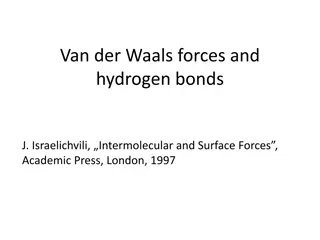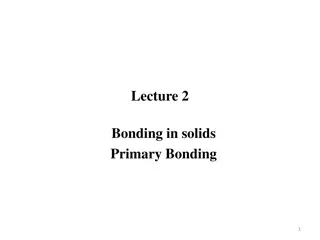Enhancing Environmental Protection with Public Interest Bonding Strategy
This document outlines the Public Interest Bonding Strategy aimed at ensuring proper financial assurance for large industrial projects in British Columbia. It covers the project overview, financial assurance concept, engagement sessions, guiding principles, and the purpose of the discussion paper. The strategy focuses on promoting forward-looking planning for environmental cleanup and reclamation while holding owners accountable for any potential environmental risks or cleanup costs. Public engagement is encouraged to provide feedback and ensure effective implementation of the mandate commitment, emphasizing transparency, accountability, and industry competitiveness.
Download Presentation

Please find below an Image/Link to download the presentation.
The content on the website is provided AS IS for your information and personal use only. It may not be sold, licensed, or shared on other websites without obtaining consent from the author. Download presentation by click this link. If you encounter any issues during the download, it is possible that the publisher has removed the file from their server.
E N D
Presentation Transcript
Engagement on the Public Interest Bonding Strategy Discussion paper
Public Engagement Sessions April 20, 9:00 11:00 April 21, 9:00 11:00 April 28, 10:00 12:00 2
Outline Project Overview What is Financial Assurance Discussion Paper Overview How to Provide Feedback Next Steps 3
Project Overview Minister s mandate commitment 2020 & 2022 With support from the Minister of Energy, Mines and Low Carbon Innovation, take steps to ensure owners of large industrial projects are bonded moving forward so that they not British Columbians pay the full costs of environmental cleanup if their projects are abandoned. 4
What is the Public Interest Bonding Strategy? Created to address the mandate commitment Two-phased comprehensive review of financial assurance requirements across the natural resource ministries 5
What is Financial Assurance? The purpose of financial assurance is: to promote forward-looking planning of environmental clean-up and reclamation, and to encourage the progressive implementation of those activities; and to ensure timely clean-up and reclamation without additional costs to the Province should an owner of an industrial project be unable or unwilling to perform the required actions themselves. 6
Discussion Paper Purpose o Promote dialogue and gain feedback o Inform effective and efficient solutions to deliver on the mandate commitment Link to webpage https://engage.gov.bc.ca/govtogetherbc/consultation/pu blic-interest-bonding/ 7
Guiding Principles The polluter pays is the overarching principle A subset of principles include: 1. Consistent with the Declaration Act 2. Risk-based approach 3. Maintain industry competitiveness and financial viability 4. Reduce and mitigate environmental risk 5. Transparent and accountable decisions 6. Consistent, compatible, and fair decision-making 8
Overview of Discussion Paper Purpose o Overview of preliminary ideas on how to strengthen BC s approach to financial assurance o Promote dialogue and gain feedback to help inform solutions Categories A. Legal Framework B. Statutory Liability Tools C. Financial Assurance Mechanisms 9
Category A. Legal Framework Explores desired outcomes and potential opportunities to strengthen the overarching legal framework for financial assurance requirements in British Columbia 11
Outcome One Better environmental clean-up and reclamation requirements regarding closure and decommissioning of industrial projects. Opportunities: Clarify and define environmental clean-up and reclamation Improve plans for site decommissioning and reclamation 12
Outcome Two Better tools to support transparent and accountable financial assurance decisions. Opportunities: Require financial assurance for specific types of industrial projects Set the appropriate amount and form of financial assurance to require Confirm the amount of liability against which financial assurance is collected 13
Outcome Three Additional types of financial assurance. Opportunities: Allow the use of pooled funds to support: More efficient use of fees and interest Additional payment options More affordable payment options 14
Category B. Statutory Liability Tools Hold companies legally responsible for the costs of cleaning up environmental damage that has happened or is imminent Complement the use of financial assurance 15
Outcome Four Improved liability tools. Opportunities: Create clear obligations for environmental clean-up and reclamation Develop consistent financial assurance requirements Obtain, review, update, and spend financial assurance at appropriate times Strengthen the Province s ability to collect financial assurance that is required but has not been received collect funds when the responsible parties are insolvent collect monies owing Create or expand the liability of directors, officers, and related corporations 16
Category C. Financial Assurance Mechanisms Financial assurance mechanisms support liability rules. If the owner of an industrial project is unwilling or unable to fulfill their environmental clean-up and reclamation obligations, the Province can draw upon financial assurance to fund necessary mitigations 17
Outcome Five Better risk-based decisions to prioritize financial assurance requirements. Opportunities: Identify and prioritize industries and/or projects with the highest potential risk 18
Outcome Six Improvements to policies and procedures (or a protocol) to guide transparent and accountable financial assurance decisions. Opportunities: Support fair and consistent financial assurance requirements 19
Outcome Seven Better approaches to minimize financial burden on industry while continuing to uphold and strengthen the polluter pays principle. Opportunities: Flexible financial assurance options Transition periods Risk-based approach to determining financial assurance amounts 20
Outcome Eight Improved liability cost estimates. Opportunities: Revise and update environmental clean-up and reclamation liability cost estimate information requirements Improve methods and tools for estimating environmental clean-up and reclamation costs 21
Outcome Nine Better data management systems and tools. Opportunities: Improve transparency with respect to how environmental cleanup and reclamation liabilities are determined Improve how the Province manages environmental cleanup and reclamation liabilities and the required financial assurance to back these liabilities 22
Next Steps Attend engagement sessions View the discussion paper online at https://engage.gov.bc.ca/govtogetherbc/co nsultation/public-interest-bonding Provide feedback online by May 28, 2022 Feedback will inform a What We Heard report 23
Discussion Paper Questions Examples: 1. In defining environmental clean-up and reclamation, what key elements are most important to you, your industry or your organization? 2. What do you think are the most important considerations when determining which industrial projects should require a closure plan? 3. What is your feedback on how to support transparent and accountable financial assurance decisions? 4. How could pooled funds be used as a tool to support the Guiding Principles of the Public Interest Bonding Strategy? 24
Questions? Comments? 26




























